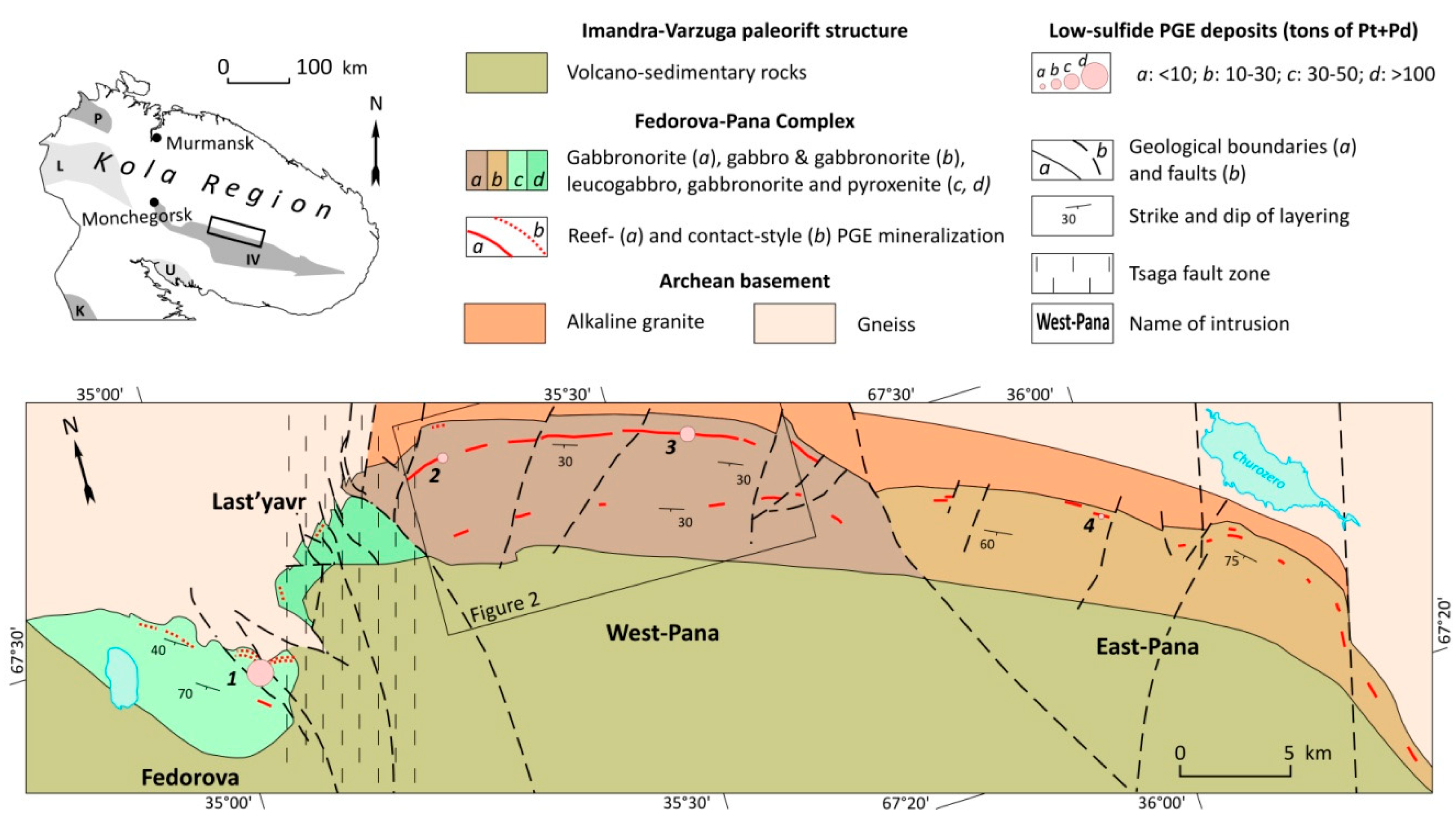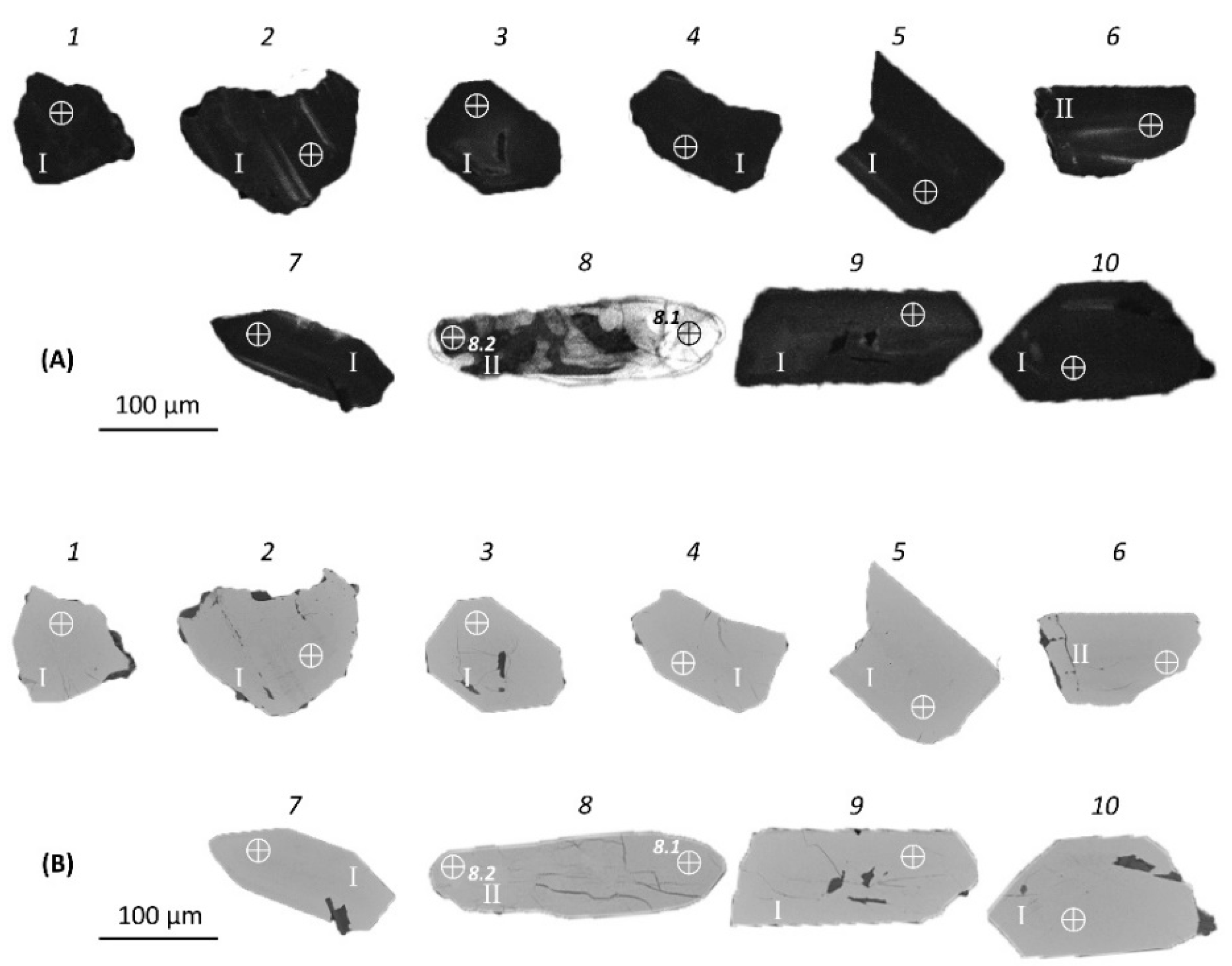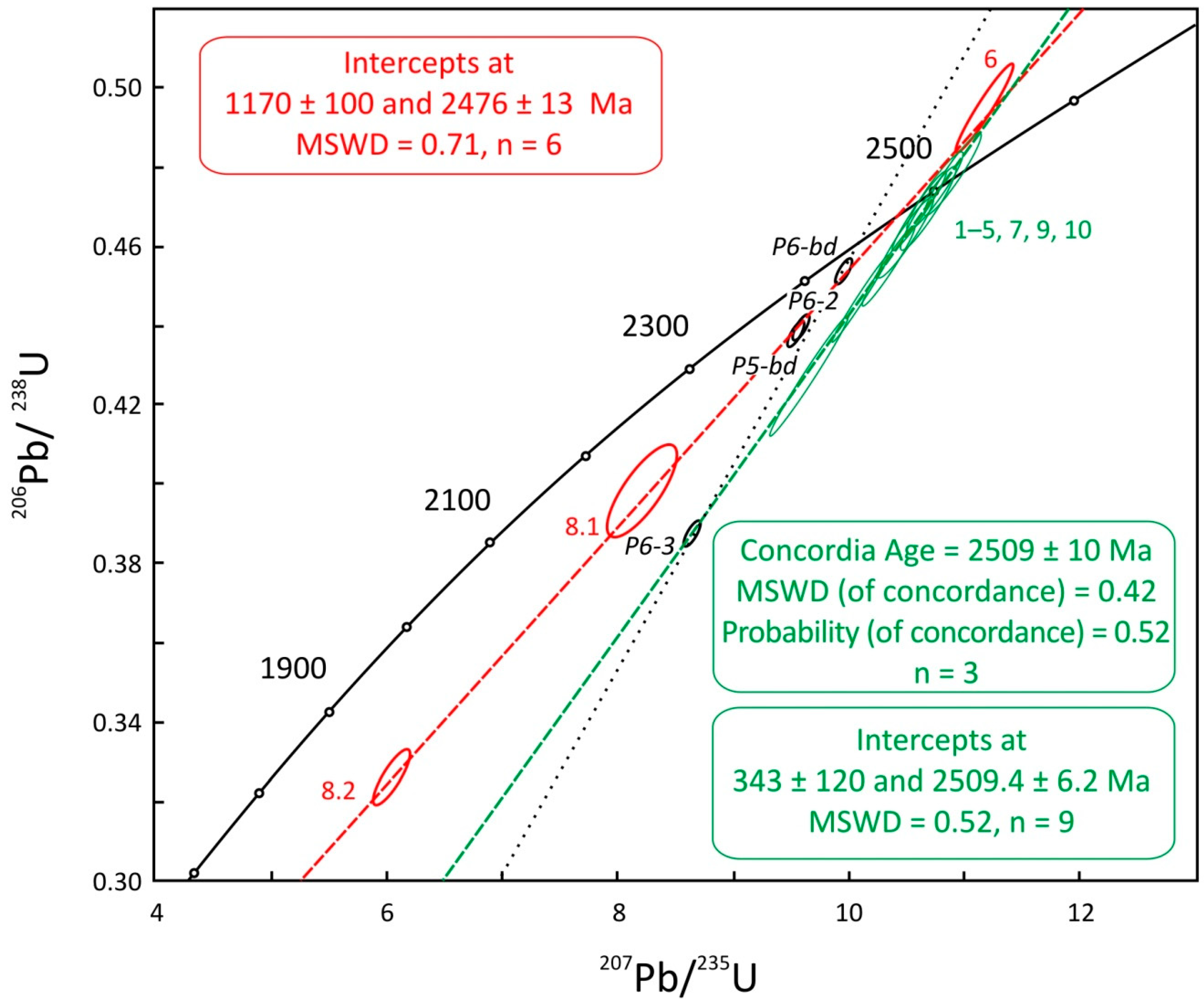The Main Anorthosite Layer of the West-Pana Intrusion, Kola Region: Geology and U-Pb Age Dating
Abstract
:1. Introduction
2. Geological Setting
3. Materials and Methods
4. Results of Zircon Imaging and U-Pb SHRIMP Dating
5. Discussion
5.1. U-Pb Age of the Main Anorthosite Layer and Crystallization History of the West-Pana Intrusion
5.2. Implications for the Formation of the South Reef
6. Concluding Remarks
Author Contributions
Funding
Acknowledgments
Conflicts of Interest
References
- Schissel, D.; Tsvetkov, A.A.; Mitrofanov, F.P.; Korchagin, A.U. Basal Platinum-Group Element Mineralization in the Federov Pansky Layered Mafic Intrusion, Kola Peninsula, Russia. Econ. Geol. 2002, 97, 1657–1677. [Google Scholar] [CrossRef]
- Korchagin, A.U.; Subbotin, V.V.; Mitrofanov, F.P.; Mineev, S.D. Kievey PGE-Bearing Deposit in the West-Pana Layered Intrusion. Strat. Min. Resour. Lapland Apatity 2009, 2, 12–32. [Google Scholar]
- Korchagin, A.U.; Goncharov, Y.V.; Subbotin, V.V.; Groshev, N.Y.; Gabov, D.A.; Ivanov, A.N.; Savchenko, Y.E. Geology and Composition of the Ores of the Low-Sulfide North Kamennik PGE Deposit in the West-Pana Intrusion. Ores Met. 2016, 1, 42–51. (In Russian) [Google Scholar]
- Kazanov, O.V.; Kalinin, A. The Structure and PGE Mineralization of the East Pansky Layered Massif. Strat. Min. Resour. Lapland-Base Sustain. Dev. North. Interreg-Tacis Proj. Apatity Russ. 2008, 1, 57–68. [Google Scholar]
- Rasilainen, K.; Eilu, P.; Halkoaho, T.; Iljina, M.; Karinen, T. Quantitative Mineral Resource Assessment of Undiscovered PGE Resources in Finland. Ore Geol. Rev. 2010, 38, 270–287. [Google Scholar] [CrossRef]
- Gurskaya, L.I.; Dodin, D.A. Mineral Resources of Platinum Group Metals in Russia: Expansion Prospects. Reg. Geol. Met. 2015, 64, 84–93. (In Russian) [Google Scholar]
- Balabonin, N.L.; Korchagin, A.U.; Latypov, R.M.; Subbotin, V.V. Fedorovo-Pansky Intrusion. In Kola Belt of Layered Intrusions. Geological Institute Kola Science Centre, Russian Academy of Sciences, Apatity, 7th International Platinum Symposium. Guide to the Pre-Symposium Field Trip; KSC RAS: Apatity, Russia, 1994; pp. 9–41. [Google Scholar]
- Mitrofanov, F.P.; Korchagin, A.U.; Dudkin, K.O.; Rundkvist, T.V. Fedorova-Pana Layered Mafic Intrusion (Kola Peninsula, Russia): Approaches, Methods, and Criteria for Prospecting PGEs. In Exploration for Platinum-Group Elements Deposits; Short Course Delivered on Behalf of the Mineralogical Association of Canada in Oulu, Finland; University of Toronto: Toronto, ON, Canada, 2005; Volume 35, pp. 343–358. [Google Scholar]
- Groshev, N.Y.; Borisenko, Y.S.; Savchenko, Y.E. Plagioclase Composition through the Section of the Main Anorthosite Layer of the West-Pana Massif (Kola Peninsula, Russia): New Data. Vestn. KSC 2017, 1, 1–15. (In Russian) [Google Scholar]
- Subbotin, V.V.; Korchagin, A.U.; Savchenko, E.E. Platinum Mineralization of the Fedorova-Pana Ore Node: Types of Ores, Mineral Compositions and Genetic Features. Vestn. KSC 2012, 1, 54–65. (In Russian) [Google Scholar]
- Chernyavsky, A.V.; Groshev, N.Y.; Korchagin, A.U.; Shilovskikh, V.V. Minerals of Platinum Group Elements through the South Reef, West-Pana Intrusion. Tr. FNS 2018, 15, 392–395. (In Russian) [Google Scholar] [CrossRef]
- Karpov, S.M. Geological Structure of the Pana Intrusion and Features of Localization of Complex PGE Mineralization. Ph.D. Thesis, KSC RAS, Apatity, Russia, 2004. (In Russian). [Google Scholar]
- Bayanova, T.; Ludden, J.; Mitrofanov, F. Timing and Duration of Palaeoproterozoic Events Producing Ore-Bearing Layered Intrusions of the Baltic Shield: Metallogenic, Petrological and Geodynamic Implications. Geol. Soc. Lond. Spec. Publ. 2010, 323, 165–198. [Google Scholar] [CrossRef]
- Mitrofanov, F.P.; Bayanova, T.B.; Korchagin, A.U.; Groshev, N.Y.; Malitch, K.N.; Zhirov, D.V.; Mitrofanov, A.F. East Scandinavian and Noril’sk Plume Mafic Large Igneous Provinces of Pd-Pt Ores: Geological and Metallogenic Comparison. Geol. Ore Depos. 2013, 55, 305–319. [Google Scholar] [CrossRef]
- Zeh, A.; Ovtcharova, M.; Wilson, A.H.; Schaltegger, U. The Bushveld Complex Was Emplaced and Cooled in Less than One Million Years—Results of Zirconology, and Geotectonic Implications. Earth Planet. Sci. Lett. 2015, 418, 103–114. [Google Scholar] [CrossRef]
- Amelin, Y.V.; Heaman, L.M.; Semenov, V.S. U-Pb Geochronology of Layered Mafic Intrusions in the Eastern Baltic Shield: Implications for the Timing and Duration of Paleoproterozoic Continental Rifting. Precambrian Res. 1995, 75, 31–46. [Google Scholar] [CrossRef]
- Dokuchaeva, V.S. Petrology and Ore Genesis in the Federov Pansky Intrusion. Geol. Genes. Platin.-Gr. Met. Depos. Mosc. Nauk. Publ. House 1994, 1, 87–100. (In Russian) [Google Scholar]
- Odinets, A.Y. The Petrology of the Pansky Massif of Mafic Rocks, Kola Peninsula. Ph.D. Thesis, Kola Branch AS USSR, Apatity, USSR, 1971. (In Russian). [Google Scholar]
- Kozlov, E.K. Natural Series of Nickel-Bearing Intrusion Rocks and Their Metallogeny; Nauka: Leningrad, USSR, 1973. (In Russian) [Google Scholar]
- Staritsina, G.N. Fedorova Tundra Massif of Basic-Ultrabasic Rocks. In Issues of Geology and Mineralogy, Kola Peninsula; Kola Branch AS USSR: Apatity, Russia, 1978; pp. 50–91. (In Russian) [Google Scholar]
- Latypov, R.M.; Chistyakova, S.Y. Mechanism of Differentiation of the West Pansky Tundra Layered Intrusion; Kola Science Center: Apatity, Russia, 2000. (In Russian) [Google Scholar]
- Latypov, R.M.; Mitrofanov, F.P.; Skiba, V.I.; Alapieti, T.T. The Western Pansky Tundra Layered Intrusion, Kola Peninsula: Differentiation Mechanism and Solidification Sequence. Petrology 2001, 9, 214–251. [Google Scholar]
- Latypov, R.M.; Mitrofanov, F.P.; Alapieti, T.T.; Halkoaho, T.A.A. Petrology of the Lower Layered Horizon of the Western Pansky Tundra Intrusion, Kola Peninsula. Petrology 1999, 7, 482–508. [Google Scholar]
- Korchagin, A.U.; Subbotin, V.V.; Mitrofanov, F.P.; Mineev, S.D. Kievey PGE-Bearing Deposit of the West-Pana Layered Intrusion: Geological Structure and Ore Composition. In Strategic Mineral Resources of Lapland—Base for the Sustainable Development of the North; KSC RAS: Apatity, Russia, 2009; pp. 12–33. [Google Scholar]
- Latypov, R.M.; Chistyakova, S.Y. Physicochemical Aspects of Magnetite Gabbro Formation in the Layered Intrusion of the Western Pansky Tundra, Kola Peninsula, Russia. Petrology 2001, 9, 25–45. [Google Scholar]
- Latypov, R.M.; Mitrofanov, F.P.; Alapieti, T.T.; Kaukonen, R.J. Petrology of the Upper Layered Horizon of the West-Pansky Tundra Intrusion (Kola Peninsula, Russia). Geol. I Geofiz. 1999, 40, 1434–1456. [Google Scholar]
- Groshev, N.Y.; Rundkvist, T.V.; Bazay, A.V. Find of Cordierite Hornfels in the Upper Layered Horizon of the West-Pana Intrusion, Kola Peninsula. Zap. RMO 2015, 144, 82–98. [Google Scholar]
- Subbotin, V.V.; Korchagin, A.U.; Savchenko, E.E. PGE Mineralization of the Fedorova-Pana Ore Complex: Types of Mineralization, Mineral Composition, Features of Genesis. Her. Kola Sci. Cent. RAS 2012, 1, 55–66. [Google Scholar]
- Groshev, N.Y. Plagioclase Composition as an Indicator of the Economic Potential of a PGE Reef in a Layered Basic Intrusion. Tr. FNS 2017, 14, 86–88. [Google Scholar]
- Subbotin, V.V.; Korchagin, A.U.; Gabov, D.A.; Savchenko, E.E. Localization and Composition of Low-Sulfide PGE Mineralization in the West-Pana Intrusion. Tr. FNS 2012, 9, 302–307. [Google Scholar]
- Bayanova, T.B. Age of Reference Geological Complexes of the Kola Region and Duration of Magmatic Processes; Nauka: St. Petersburg, Russia, 2004. [Google Scholar]
- Williams, I.S. U-Th-Pb Geochronology by Ion Microprobe. Rev. Econ. Geol. 1998, 7, 1–35. [Google Scholar]
- Schuth, S.; Gornyy, V.; Berndt, J.; Shevchenko, S.; Sergeev, S.; Karpuzov, A.; Mansfeld, T. Early Proterozoic U-Pb Zircon Ages from Basement Gneiss at the Solovetsky Archipelago, White Sea, Russia. Int. J. Geosci. 2012, 03, 289–296. [Google Scholar] [CrossRef]
- Stacey, J.S.; Kramers, J.D. Approximation of Terrestrial Lead Isotope Evolution by a Two-Stage Model. Earth Planet. Sci. Lett. 1975, 26, 207–221. [Google Scholar] [CrossRef]
- Ludwig, K.R. User’s Manual for Isoplot 3.75: A Geochronological Toolkit for Microsoft Excel; Berkeley Geochronology Center: Berkeley, CA, USA, 2012. [Google Scholar]
- Heaman, L.M.; LeCheminant, A.N. Paragenesis and U-Pb Systematics of Baddeleyite (ZrO2). Chem. Geol. 1993, 110, 95–126. [Google Scholar] [CrossRef]
- Chashchin, V.V.; Mitrofanov, F.P. The Paleoproterozoic Imandra-Varzuga Rifting Structure (Kola Peninsula): Intrusive Magmatism and Minerageny. Geodin. I Tektonofiz. 2015, 5, 231–256. [Google Scholar] [CrossRef]
- Nitkina, E.A. U-Pb Zircon Dating of Rocks of the Platiniferous Fedorova-Pana Layered Massif, Kola Peninsula. Dokl. Earth Sci. 2006, 408, 551–554. [Google Scholar] [CrossRef]
- Groshev, N.Y.; Nitkina, E.A.; Mitrofanov, F.P. Two-Phase Mechanism of the Formation of Platinum-Metal Basites of the Fedorova Tundra Intrusion on the Kola Peninsula: New Data on Geology and Isotope Geochronology. Dokl. Earth Sci. 2009, 427, 1012–1016. [Google Scholar] [CrossRef]
- Balashov, Y.A.; Bayanova, T.B.; Mitrofanov, F.P. Isotope Data on the Age and Genesis of Layered Basic-Ultrabasic Intrusions in the Kola Peninsula and Northern Karelia, Northeastern Baltic Shield. Precambrian Res. 1993, 64, 197–205. [Google Scholar] [CrossRef]
- Bayanova, T.B.; Rundquist, T.V.; Serov, P.A.; Korchagin, A.U.; Karpov, S.M. The Paleoproterozoic Fedorov-Pana Layered PGE Complex of the Northeastern Baltic Shield, Arctic Region: New U-Pb (Baddeleyite) and Sm-Nd (Sulfide) Data. Dokl. Earth Sci. 2017, 472, 1–5. [Google Scholar] [CrossRef]
- Wall, C.J.; Scoates, J.S.; Weis, D.; Friedman, R.M.; Amini, M.; Meurer, W.P. The Stillwater Complex: Integrating Zircon Geochronological and Geochemical Constraints on the Age, Emplacement History and Crystallization of a Large, Open-System Layered Intrusion. J. Pet. 2018, 59, 153–190. [Google Scholar] [CrossRef]
- Scoates, J.S.; Friedman, R.M. Precise Age of the Platiniferous Merensky Reef, Bushveld Complex, South Africa, by the U-Pb Zircon Chemical Abrasion ID-TIMS Technique. Econ. Geol. 2008, 103, 465–471. [Google Scholar] [CrossRef]
- Wall, C.J.; Scoates, J.S. High-Precision U-Pb Zircon-Baddeleyite Dating of the JM Reef Platinum Group Element Deposit in the Stillwater Complex, Montana (USA). Econ. Geol. 2016, 111, 771–782. [Google Scholar] [CrossRef]
- Karykowski, B.T.; Maier, W.D.; Groshev, N.Y.; Barnes, S.J.; Pripachkin, P.V.; McDonald, I. Origin of Reef-Style Pge Mineralization in the Paleoproterozoic Monchegorsk Complex, Kola Region, Russia. Econ. Geol. 2018, 113, 1333–1358. [Google Scholar] [CrossRef]
- Karykowski, B.T.; Maier, W.D.; Groshev, N.Y.; Barnes, S.J.; Pripachkin, P.V.; McDonald, I.; Savard, D. Critical Controls on the Formation of Contact-Style PGE-Ni-Cu Mineralization: Evidence from the Paleoproterozoic Monchegorsk Complex, Kola Region, Russia. Econ. Geol. 2018, 113, 911–935. [Google Scholar] [CrossRef]
- Karykowski, B.T.; Maier, W.D. Microtextural Characterisation of the Lower Zone in the Western Limb of the Bushveld Complex, South Africa: Evidence for Extensive Melt Migration within a Sill Complex. Contrib. Miner. Pet. 2017, 172, 1–18. [Google Scholar] [CrossRef]
- Ivanov, A.N.; Groshev, N.Y.; Korchagin, A.U. Transgressive Structures of the Lower Layered Horizon in the Area of North Kamennik Low-Sulfide PGE Deposit. Tr. FNS 2018, 15, 124–127. [Google Scholar] [CrossRef]
- Groshev, N.Y.; Pripachkin, P.V. Geological setting and platinum potential of the Gabbro-10 massif, Monchegorsk Complex, Kola Region. Ores Met. 2018, 4, 4–13. [Google Scholar] [CrossRef]








| Spot/Fraction Name | 206Pbc (%) | Concentrations/Ratios | 206Pb/238U-age (Ma) | 207Pb/206Pb-age (Ma) | D (%) | Isotope Ratios | Rho | ||||||||
|---|---|---|---|---|---|---|---|---|---|---|---|---|---|---|---|
| U (ppm) | Th (ppm) | Th/U | 206Pb * (ppm) | 207Pb */ 206Pb * | 1σ (%) | 207Pb */ 235U | 1σ (%) | 206Pb */ 238U | 1σ (%) | ||||||
| SHRIMP data, this study | |||||||||||||||
| 1.1 | 0.01 | 787 | 1003 | 1.32 | 302 | 2383 ± 34 | 2497.0 ± 3.8 | 5 | 0.1640 | 0.22 | 10.110 | 1.7 | 0.4472 | 1.7 | 0.992 |
| 2.1 | 0.01 | 304 | 310 | 1.06 | 119 | 2416 ± 29 | 2507.6 ± 6.2 | 4 | 0.1650 | 0.37 | 10.350 | 1.5 | 0.4547 | 1.5 | 0.969 |
| 3.1 | 0.05 | 186 | 141 | 0.78 | 74 | 2448 ± 30 | 2506.0 ± 7.9 | 2 | 0.1649 | 0.47 | 10.500 | 1.5 | 0.4618 | 1.5 | 0.952 |
| 4.1 | 0.03 | 444 | 373 | 0.87 | 179 | 2475 ± 29 | 2501.3 ± 4.9 | 1 | 0.1644 | 0.29 | 10.610 | 1.5 | 0.4681 | 1.4 | 0.980 |
| 5.1 | 0.05 | 399 | 1436 | 3.72 | 146 | 2292 ± 46 | 2497.7 ± 5.5 | 9 | 0.1640 | 0.33 | 9.660 | 2.4 | 0.4270 | 2.4 | 0.991 |
| 6.1 | 0.04 | 210 | 28 | 0.14 | 89 | 2586 ± 31 | 2499.6 ± 7.3 | −3 | 0.1642 | 0.43 | 11.170 | 1.5 | 0.4935 | 1.5 | 0.959 |
| 7.1 | 0.10 | 228 | 268 | 1.22 | 92 | 2480 ± 30 | 2511.6 ± 7.2 | 1 | 0.1654 | 0.43 | 10.700 | 1.5 | 0.4691 | 1.5 | 0.960 |
| 8.1 | 0.24 | 29 | 25 | 0.87 | 10 | 2160 ± 36 | 2340.0 ± 25.0 | 8 | 0.1495 | 1.50 | 8.200 | 2.4 | 0.3980 | 1.9 | 0.794 |
| 8.2 | 0.05 | 416 | 120 | 0.30 | 116 | 1818 ± 23 | 2159.0 ± 14.0 | 19 | 0.1346 | 0.83 | 6.046 | 1.7 | 0.3258 | 1.4 | 0.865 |
| 9.1 | 0.06 | 200 | 405 | 2.09 | 82 | 2516 ± 30 | 2513.2 ± 7.7 | 0 | 0.1656 | 0.46 | 10.900 | 1.5 | 0.4775 | 1.5 | 0.954 |
| 10.1 | 0.04 | 371 | 333 | 0.93 | 151 | 2498 ± 30 | 2506.4 ± 8.6 | 0 | 0.1649 | 0.51 | 10.760 | 1.5 | 0.4733 | 1.4 | 0.942 |
| ID-TIMS data from [13] | |||||||||||||||
| P6-2 | nd | 1331 | nd | nd | 743 | nd | 2438 | nd | nd | nd | 9.588 | 0.5 | 0.4393 | 0.5 | 0.865 |
| P6-3 | nd | 577 | nd | nd | 286 | nd | 2474 | nd | nd | nd | 8.643 | 0.5 | 0.3874 | 0.5 | 0.794 |
| P5-bd | nd | 396 | nd | nd | 176 | nd | 2435 | nd | nd | nd | 9.548 | 0.5 | 0.4380 | 0.5 | 0.865 |
| P6-bd | nd | 560 | nd | nd | 259 | nd | 2443 | nd | nd | nd | 9.956 | 0.5 | 0.4533 | 0.5 | 0.794 |
| Intrusions | Rock Type | Age (Ma) | Mineral | References |
|---|---|---|---|---|
| Fedorova | gabbronorite min. | 2485 ± 9 | 4 Zrn, SD | [38] |
| gabbronorite min. | 2493 ± 8 | 4 Zrn, SD | [39] | |
| orthopyroxenite | 2526 ± 6 | 4 Zrn, SD | [38] | |
| leucogabbro min. | 2518 ± 9 | 3 Zrn, SD | [39] | |
| leucogabbro | 2515 ± 12 | 4 Zrn, SD | [39] | |
| leucogabbro | 2516 ± 7 | 3 Zrn, SD | [38] | |
| leucogabbronorite | 2507 ± 11 | 6 Zrn, D | [39] | |
| West-Pana | norite | 2497 ± 3 | 4 Zrn, SD | [38] |
| gabbronorite | 2496 ± 7 | 3 Zrn, D | [38] | |
| gabbronorite | 2491 ± 1.5 | 3 Zrn, D | [13] | |
| gabbronorite | 2501.5 ± 1.7 | 3 Zrn, C | [16] | |
| gabbro-pegmatite | 2470 ± 9 | 3 Zrn, DC | [40] | |
| magnetite gabbro | 2498 ± 5 | 3 Zrn, DC | [13] | |
| anorthosite | 2447 ± 12 | 3 Zrn + 2Bdy, DC | [13] | |
| East-Pana | gabbro | 2487 ± 10 | 4 Zrn, SD | [12] |
| gabbro-pegmatite | 2464 ± 12 | 2 Zrn + 2Bdy, SD | [41] |
© 2019 by the authors. Licensee MDPI, Basel, Switzerland. This article is an open access article distributed under the terms and conditions of the Creative Commons Attribution (CC BY) license (http://creativecommons.org/licenses/by/4.0/).
Share and Cite
Groshev, N.Y.; Karykowski, B.T. The Main Anorthosite Layer of the West-Pana Intrusion, Kola Region: Geology and U-Pb Age Dating. Minerals 2019, 9, 71. https://doi.org/10.3390/min9020071
Groshev NY, Karykowski BT. The Main Anorthosite Layer of the West-Pana Intrusion, Kola Region: Geology and U-Pb Age Dating. Minerals. 2019; 9(2):71. https://doi.org/10.3390/min9020071
Chicago/Turabian StyleGroshev, Nikolay Y., and Bartosz T. Karykowski. 2019. "The Main Anorthosite Layer of the West-Pana Intrusion, Kola Region: Geology and U-Pb Age Dating" Minerals 9, no. 2: 71. https://doi.org/10.3390/min9020071
APA StyleGroshev, N. Y., & Karykowski, B. T. (2019). The Main Anorthosite Layer of the West-Pana Intrusion, Kola Region: Geology and U-Pb Age Dating. Minerals, 9(2), 71. https://doi.org/10.3390/min9020071





